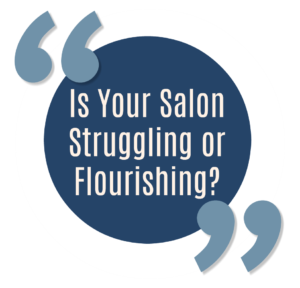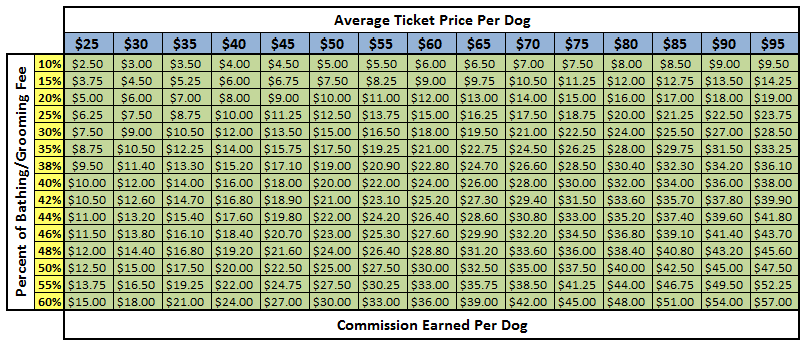How and what professional groomers get paid is always a hot topic. There are so many variables:
- Hourly?
- Commission?
- Pay rates?
 Over the years I’ve tested just about every possible combination of scenarios to try to determine what was fair, what worked, and what didn’t.
Over the years I’ve tested just about every possible combination of scenarios to try to determine what was fair, what worked, and what didn’t.
When I started my first business, I groomed in the vans right beside my mobile groomers. My team earned 50% commission of the grooming charges. We also had an extra “house call charge” for the front door service per stop (not per dog).
My mobile fleet grew from one van to six in about five years. Plus, I added a grooming salon to the mix. We were busy all the time. However, every once in a while, cash got tight.
Have you ever been there?
As we grew, the cash flow would have high and low swings. When the swing went up, it was fun, and I could reinvest in the company. I would buy another van and pay for continuing education for both myself and my team. We celebrated when we met sales quotas.
Occasionally, I would struggle to make a payment. If catching up got too deep and available cash got tight, I would grab a credit card. In those moments, I needed to keep the vans on the road and take care of expenses no matter how high the interest rates.
The busier we got, the less I paid attention to the finances. After all, we were all working and bringing in money. It was inconceivable to think we wouldn’t have enough money to pay the bills or commission.
 But then it happened.
But then it happened.
A payroll check bounced. The lights got turned off. The phone service got shut off.
Each of these stressful, embarrassing, and terrifying moments are the hard lessons many business owners face.
Early in my career, I didn’t pay attention to the financial health of my business. It was a painful lesson I needed to learn the hard way. I was losing sleep over it and after more than one negative incident, I vowed never to let it happen again.
Detailed bookkeeping wasn’t my forte – I would rather have been grooming. However, I bit the bullet and invested in a bookkeeper. She was much wiser than I when it came to money matters. She made sense of the income and the expenses and I started paying attention to my cash flow.
We worked closely together and each month she would create a profit and loss statement for me. It would contain all the standard categories along with monthly and year-to-date figures. Plus, she added a column that tracked the percentage of expenses to sales.
The percentages were critical. No matter how rapidly we grew, I started to see trends in the percentages. It allowed me to easily track the fiscal health of my companies at a glance.
Early in my first mobile business, the only thing really saving the company was the house call charge on top of the grooming fee. Little did I realize how detrimental a 50% commission rate was to the health of a business. It’s very hard to run a profitable company when you pay out almost half of your grooming revenue.
It’s even more challenging if you had W-2 employees vs. independent contractors (but that’s a whole ‘nother blog!). In the state of Michigan, an estimated 13% was paid in payroll tax obligations for my staff based on their wages.
Look at the chart below. If you are a commissioned groomer/stylist, find your rate. Next, find your average price per dog. For example, if you earn a 50% commission rate and the average ticket price of the dog is $50, you would be earning $25 per dog.

Did you find your place on the chart?
Notice what happens to the earning potential when pets are priced higher, yet the commission rate is lower?
Where would you rather work – at a salon with lower-priced dogs but at the 50% rate or at a higher priced salon with a lower commission?
The commission rate isn’t the true barometer of your earning potential. The price per dog combined with the commission rate is what you need to look at. Even if a commission rate is 38% but the average ticket price is $70, you would be earning $1.60 MORE than the 50% commission rate at $50 average grooming price.
Don’t get hung up on the commission rate. Pay attention to the average price per pet COMBINED with a commission rate. Then, do the math. It might surprise you!
In the next set of charts, I want to demonstrate what happens to a business paying out a 50% commission rate to employees. In these examples, I have simplified salon expenses. Most salons will have a longer list of expenses. The examples show how the numbers would play out over the course of a year. As you look through the amounts, notice what happens.

I have used a 50% commission rate for salon generating $150,000 per year.

The salon is generating $210,000 annually while paying out a commission of 50% to the groomers.

The salon is still generating $150,000 per year but now the commission rate has fallen to 44%.

The grooming commission rate is 44% but the average ticket price increased per dog, earning the salon $210,000 annually.
In example A, the salon is clearing $5,910 for the entire year or less than $500 each month.
If you are a salon owner, I’m guessing you did not get into business to run a nonprofit company. In this scenario, that’s pretty much what’s happening. Remember, I simplified the outgoing costs of the businesses. Most salons will have more bills to pay than reflected in this example.
If you are an employee working at a salon paying 50%, you feel it every day. The lack of cash flow filters through. Chances are, the salon struggles to make ends meet. It has to cut corners. One financial hiccup can send it into a downward spiral.
The only way a 50% commission-based salon can truly make ends meet is if the salon owner is also one of the groomers. Another option is to have other streams of income other than just grooming.
Raising prices and dropping the commission rates is in the best interest of a business. It creates a cash flow buffer which takes the pressure off everything and everyone. It allows the business to thrive instead of struggle. It allows for higher-quality products, equipment, and education. These items make the workspace more enjoyable while minimizing burnout and maximizing quality.
Most salon owners and their employees are among the most passionate people I know. We’re hard workers and love pets. Owners and staff need to work together as a team. Everyone needs to understand what the numbers look like in order to have an enjoyable work environment.
My professional grooming department at Whiskers Resort & Pet Spa currently runs with a team of seven stylists and three grooming assistants. The team has both full- and part-time employees. The sliding-scale commission rates range from 38% – 44% for full grooms based on client satisfaction, rebooking, and financial quotas. Stylists earn lower commissions on simple bath and brush pets requiring less time. Stylists can bounce up and down the tier system based on the previous quarter’s performance. Grooming assistants are paid hourly based on experience and performance. On average, the grooming department’s commission payroll runs between 36% and 43% of gross sales. With lower commission rates, we can afford to pay the assistants and a portion of the customer service team who books all the grooming appointments.
Even with lower commissions, the average ticket price runs between $65 and $70 per dog. Based on personal motivation and experience, stylists groom an average six to 12 dogs a day. As a bonus, on a typical day, a stylist can also earn anywhere from $30 – $80 in tips on top of their commission rates. This department is flourishing, and the turnover is extremely low.
Salon owners, if you don’t have a firm handle on how the dollars stack up, I encourage you to track them and pay attention. If you don’t want to deal with it yourself (like me!), hire a bookkeeper. Then work closely with them and learn. They love to tinker with numbers the same way we like to tinker with dogs!
I encourage you to compare the charts. Check out the numbers. Think about how you fit within these examples. Then run your OWN numbers and see how you stack up. It does not matter whether you are the salon owner or a commissioned stylist. The numbers don’t lie and are the key to EVERYONE’S financial health and success.
Happy trimming!
Melissa

What system do you use in YOUR business? Jump on our Facebook page and share what works best for you with your Melissa Verplank family.

